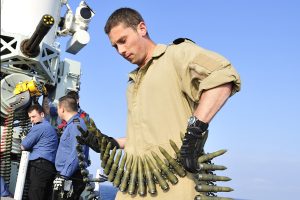Maintaining equipment at sea
By Lookout on Jul 09, 2012 with Comments 0

LS Sean Hemeon, with MS Ryan Russell (inset), both weapons technicians, help unload the Close In Weapons System on board HMCS Charlottetown.
Weapons for fighting, radar for detection and navigation, the horizon-reference system that helps the Sea King helicopter land safely — all these systems are under the care of the Combat Systems Engineering (CSE) Department, which handles much of the crucial maintenance involved in keeping a ship combat-ready at sea.
One piece of kit aboard HMCS Charlottetown is all too familiar to the members of the CSE Department: the Mk 15 PHALANX 20-mm Close-In Weapon System, abbreviated “CIWS”, known to most as the Sea Whiz.
The ship’s last ditch defence mechanism, the CIWS is a radar-guided six-barrelled Gatling-type gun system that fires bursts or continuously at either 3,000 or 4,500 rounds per minute. It is located on top of the ship’s hangar to engage fast-moving close-range targets such as diving missiles and aircraft, and attacking gun-boats.
If this powerful machine is to be ready to defend the ship, the CSE Department members must perform “the upload.”
“Whether it’s five degrees in the middle of the Atlantic Ocean in winter, or a scorching 35 degrees in the Mediterranean, this thing’s got to be ready to go at all times,” says LS Matthew Martin, a weapons technician serving in Charlottetown.
The call comes across the CSE “meet-me” net: “All on-watch CSE personnel muster CSE flats, CIWS upload.” It takes two minutes for the required personnel to get into their jackets and leather-palmed gloves. Within 10 minutes, everyone is already beginning the task, with MS Kelly Spicer and LS Timothy Tyler preparing the ammunition in a compartment immediately under the gun mount, and the rest of the group at work on the hangar roof.
To ensure its complex internal systems are always booted up and ready for action, the CIWS is kept loaded. To ensure safety until the gun is prepared for action only, dummy rounds are left in the gun system’s drum magazine and the feedway that supplies it with ammunition.
The upload is a cyclic process in which the dummy rounds are removed — downloaded — and seamlessly replaced by live rounds. Ammunition boxes rigged on a cable running through a pulley carry live ammo up to the gun mount, where LS Matthew Martin feeds it into the magazine.
Meanwhile, the gun system ejects the belts of dummy ammunition and the technicians lay them out neatly on the hangar roof. Round after round spins through the weapon and, in almost no time at all, this magnificently destructive machine is ready for another stretch of sea time.
“We just know how it works,” said LS Sean Hemeon, commenting on the speed of the process. “We know how important it is to get it done, so we get it done.”
Finally, the Air Officer has to ensure nothing has been dropped during the CIWS upload that could damage the ship’s CH-124 Sea King helicopter. Only after successful conclusion of his FOD rounds — that’s an inspection for debris that might cause Foreign Object Damage — is the group finished with their task and free to climb down from the hangar roof.
Every piece of gear the CSE department maintains requires a keen sense of focus and determination to ensure proper operation.
HMCS Charlottetown’s CSE Department ensures the operational efficiency of the CIWS as part of their contribution to the ship’s combat readiness.
AB Ryan Warnell, HMCS Charlottetown
Filed Under: Top Stories
About the Author:





